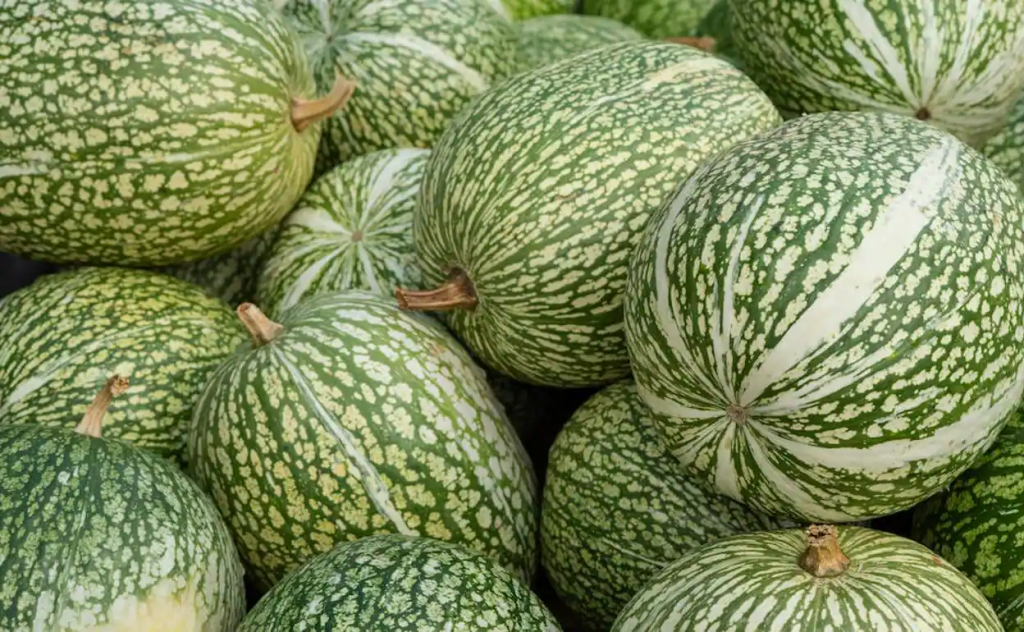The pantana is the fruit of the pantanera and a term that is part of the Historical Dictionary of the Spanish of the Canary Islands. It is a fruit with a smooth, green rind, with whitish and yellowish spots. Its flesh, juicy and white, is fibrous after being cooked and resembles a scalp, hence the name of the sweet 'angel hair', made from this fruit. In other areas of the Canary Islands the pantana is known by the name of "calabaza boba". In this article we will talk about the pantana and its journey to reach the Canary Islands. Discover it!
Description of the marsh
The pantana or cucúrbita ficifólia, popularly known as chilacayote in Mexico, Guatemala and El Salvador; chiverre in Costa Rica; alcayota in Chile and Argentina; calabaza de cabello de ángel or cidra in Spain; and calabaza boba in the Canary Islands, is a climbing species of edible fruit of the cucurbitaceae family.
It is the most important species of squash in the high altitude regions of the Neotropics. This includes the seven countries of South America where the Andes are spread. In addition to its extensive traditional cultivation area, this species has spread over the last centuries throughout the world's tropical and subtropical high altitude regions and in mild temperate zones.

Its popularity is due to its ease of cultivation in cool regions under extreme conditions of drought or humidity. At low altitudes it can be grown as a rootstock for other cucurbit vines such as melons and cucumbers. The fruits have similar nutritional qualities or flavor as the other cultivated species of squash, but have a very long shelf life due to the properties of its shell.
Uses of this popular fruit
The uses of pantana vary in different regions, but it is mainly used as food in the same place where it is grown, in small and sustainable agricultural systems. Otherwise, the fruits are sold in local markets. Its most commercial uses are in Mexico, Costa Rica, Colombia, Ecuador and Argentina, where it is used for confectionery and sweets.
Archaeological record of the marsh
The archaeological record shows that it was used and traded in pre-Inca times in northern Peru. The morphological variation of the species, although comparatively small for a domesticated Cucurbita, is wider in the region from Peru to Colombia. This indicates that its potential domestication was in this area.
Origin, cultivation and distribution of marsh in the world.
Some authors have proposed that the origin of the pantana is Central American or South Mexican-Central American, while others suggest that it is located in South America, more specifically in the Andes. The distribution area of this species covers the middle or high zones of practically all the mountain ranges of Latin America, from the north of Mexico to Chile and the northwest of Argentina. However, as in the case of its origin, the center of domestication and diversification still represents an enigma to be solved, however, the archaeological remains found in Peru tip the balance towards this area.

This species spread as a crop both inside and outside the American continent in Europe, Africa, Asia, India and finally Oceania. The first marsh fruits to reach Europe took a route from South America to the coasts of India along the well-traveled Portuguese and Dutch trade route in the 16th and 17th centuries, from where they finally reached Europe and the Canary Islands.
The marshland and angel hair in the Canary Islands
The pantana is commonly used in the Canary Islands to make the famous "cabello de ángel", which is used to prepare typical sweets such as trout. Below, we explain how to prepare the delicious cabello de ángel.
Ingredients
1 kg. of cooked marshmallow pulp; 1 kg. of sugar; 1 kg. of water; half a lemon; a stick of cinnamon.
Step-by-step processing

To make the angel hair we first wash the pumpkin well. We put a towel on the floor and throw the pumpkin on top of the towel with force so that it opens. It is advisable to do it this way, since its shell is very hard.
Once opened, cut into not very large pieces and put them in a pot and cook. If it is an express pot in 45 minutes it will be ready, if it is a conventional pot we will have to have it from an hour and a half to two hours.
Once the cooking time has elapsed, remove and drain the pieces in a colander. With the help of a spoon we remove the pulp and let it drain again in a colander. When it has cooled and has released all the water, weigh the pulp. The same weight of pulp is the same weight of sugar. With the same amount of water and sugar we prepare a syrup. We put in a case the water and the sugar and when it starts to boil we add the pumpkin pulp, together with the juice of half a lemon and a cinnamon stick.
Leave over medium-low heat for about an hour or even a little longer. We have to get all the strands of the pumpkin pulp are separated from each other and acquire a nice golden color. In addition, you have to stir it from time to time to prevent it from sticking.
With approximately one kilo of pumpkin pulp we will get three to four jars, depending on the size of the jars. We fill the jars with the angel hair candy and leave the jars upside down from one day to the next, doing this, our angel hair will last for months.
If you are interested in the world of products made in the Canary Islands and its gastronomy and you want to know more, we leave you the link to our section of Gastronomy.
Photos: El Correo, La cocina de Frabisa



